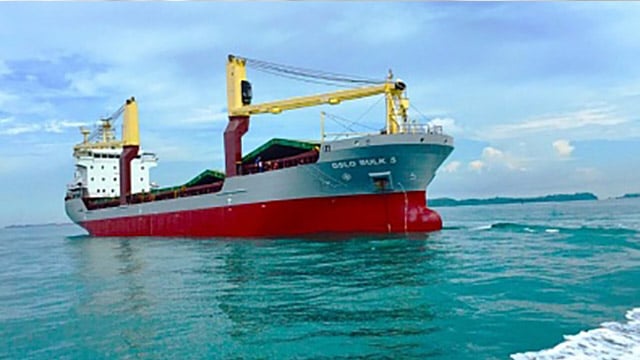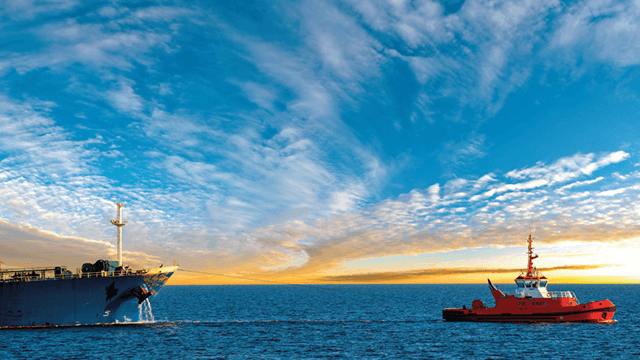With experience gathered from over a decade of work with ballast water treatment, Alfa Laval has put together informative resources to help your decision process.
Compliance, regulations, editorials and product information
“Making sense of ballast water management” offers extensive information on ballast water regulations, compliance alternatives and treatment technologies. It features important insights and technical facts, as well as illustrations, diagrams and tables. To order a printed copy of the book, fill out the form below or download the PDF.

Reach PureBallast digital hub where you can find every informative video that can help you to understand the way we work in ballast water management.

Join our ballast water treatment specialist Håkan Persson talking to an experienced ballast specialist giving an up-to-date look at the most important topics to consider when planning your installation to keep you ballast water treatment system compliant for the lifetime of your vessel.

When planning for a ballast water treatment system, there are many questions that need to be asked. Here you will find answers to common questions, both about Alfa Laval PureBallast 3 and about the legislative issues surrounding ballast water treatment.
The differences between Alfa Laval PureBallast 3 and other systems are easy to explain and difficult to ignore. No other system comes close to its capabilities.
Simply put, PureBallast 3 provides fully compliant ballast water treatment without limiting your vessel’s operations or freedom of movement. Type approved by both IMO and the U.S. Coast Guard, it can perform:
This unique combination of capabilities ensures that you have a full range of options. Your ballast water treatment system will never restrict the place or manner in which you do business.
Added to this is the uncompromising construction of PureBallast 3. Built with non-corroding super austenitic stainless steel, PureBallast 3 reactors can be expected to last up to 20 years or more without replacement.
Many of the alternatives actually have their roots in drinking water treatment. Because they are adaptations of land-based technologies for water purification, they are less suited to common marine circumstances such as low UV transmittance. By contrast, the enhanced UV treatment technology in PureBallast 3 was developed specifically for marine use.
In PureBallast 3, the reactor’s UV lamps are combined with specially designed lamp sleeves of synthetic quartz. As well as optimizing the breadth of the wavelength spectrum, the sleeves have a high transmission efficiency that results in more UV light during disinfection. Combined with the flow-optimized design of the reactor interior, they ensure optimal UV dosage and low energy consumption.
Supporting the enhanced UV treatment is an extremely effective filter stage, which removes any larger organisms and particles prior to biological disinfection. Together, the filter and reactor stages enable full-flow treatment of fresh, brackish and marine water with UV transmittance as low as 42%. No other system can match this performance.
Without some form of cleaning, deposits of calcium carbonate and metal ions will build up on the quartz sleeves of the UV lamps in a ballast water treatment system. This will impair treatment, since less of the UV light produced by the lamps will be able to pass through.
Mechanical wiping is an alternative to CIP, but wipers are ineffective against the build-up of metal ions, which must be removed with a low-pH fluid. Nor do they clean the UV sensor within the reactor, which measures the UV transmittance. If the sensor and quartz sleeves are dirty, the system may use more power than necessary or be otherwise poorly controlled.
Any form of mechanical cleaning – including manual cleaning – will also lead to sleeve scratches. Eventually, these too will degrade the treatment performance.
Simply put, tests have shown that CIP has a valuable role in maintaining the biological disinfection performance of a ballast water treatment system. In a UV-based system, the effects are noticeable after a single cleaning operation. Moreover, by reducing energy use and maximizing the lifetime of the quartz sleeves, CIP has a long-term role in keeping operating costs down.
The answer is yes, in both respects.
PureBallast 3 Compact Flex is the answer to space and flexibility concerns. Ideal for most vessels, it arrives as loose components for installation freedom. Simply put, it packs the leading ballast water treatment system into the market’s smallest footprint – at reduced installation cost. Free placement of the lamp drive cabinet up to 30 m away allows further space savings in cramped spaces.
Where space permits, PureBallast 3 Compact can even be delivered as a skid-mounted, plug-and-play solution with the market’s smallest footprint., which even further simplify both Engineering and installation saving time and money.
PureBallast 3 non-Ex and Ex are both delivered in loose components, with high flexibility, with placement of the lamp drive cabinet up to 150 m away allows further space savings in the engine room, as well as placement outside the hazardous zone for Ex systems.
Because no salt or chemicals are used, there is no need for additional tanks or ventilation systems. Nor is any manual intervention – such as the opening and closing of valves – needed from the crew. Operation is fully automatic and started or stopped with a push of a button, either via the graphical touchscreen interface or via the vessel’s Integrated Ship Control System.
Efficiency can refer to two things in a ballast water treatment system: biological disinfection performance or energy consumption. In practice, however, these things go hand in hand.
In terms of biological disinfection performance, no system is more efficient at neutralizing ballast water than PureBallast 3. Only PureBallast 3 can perform in all water types and in water with UV transmittance as low as 42%. This it can do at full flow, i.e. without reducing the speed of ballast operations.
Because of its high performance, PureBallast 3 is also highly energy efficient. In most situations, it can run at just 50% of its potential operating power when sailing in IMO-regulated waters. Only when needed, for example in waters with extremely low UV transmittance, is it ramped up to its full installed power.
Ballast water treatment has been discussed for many years. Now that the IMO Ballast Water Management (BWM) Convention has been ratified, the issue has become urgent worldwide.
Now that the BWM Convention has entered into force, there is no time left to wait. Even if your vessel has just had a renewal survey, it will need to have a ballast water treatment system retrofitted by its first renewal survey after September 2019. This will take more time and resources than many ship owners expect, so early commitment and good planning are keys to success.
In essence, all vessels will have to install a treatment system within a period of around seven years. As a result, there will be a tremendous demand for systems and shipyard slots. Literally thousands of vessels will be competing for both supplier and shipyard capacity.
Many suppliers lack the production strength to scale up in the coming years, or the experience to ensure smooth delivery and installation with the many parties involved. For you to receive a compliant system in time, you must choose a supplier who is able to do both.
If you need to deballast in the United States, you must be even more selective in your choice. In order to comply with the U.S. Coast Guard (USCG) Ballast Water Discharge Standard, which became law in 2012, you need a system that is specifically approved for use by the USCG.
The BWM Convention serves as the main international guideline for ballast water treatment systems. However, it was established when far less was known about the control mechanisms needed for ballast water treatment. As the application has evolved, so has IMO testing, becoming more uniform and stricter.
IMO type approval certificates issued since 2014 may offer more detail about the Operating limitations of a system, such salinity, temperature and UV transmittance levels. Certificates issued before this date should be examined critically and the newest revision of a certificate should always be sought.
The USCG type approval system was designed much later and with transparency in mind. USCG type approvals, which have been issued for a handful of systems to date, offer a solid indication of system capability.
Type approval testing by an authorized third party is important to ensure transparency, validity and ultimately system compliance. Third-party testing bodies can ensure a controlled testing environment and realistic test conditions, which will prevent system deficiencies from being overlooked.
For example, organisms that live near the water surface have a much higher tolerance for UV light than those that live deeper down. To neutralize these organisms effectively, medium-pressure UV lamps are needed. But by using a cultivated mixture that excludes these organisms, it is possible to meet requirements while cutting corners technologically.
Today much has been learned about the control mechanisms needed to ensure compliance. Serious suppliers choose robust UV technology, seek third-party transparency and perform their tests with water that contains naturally occurring organisms, as Alfa Laval has done with Alfa Laval PureBallast 3.
Inconsistencies in IMO type approval have led to growing demands for a control mechanism. Spot checks have been proposed, in order to ensure that IMO-certified treatment systems do their job in actual operation. Naturally, the responsibility for the checks would fall to Port State Control.
In reality, this raises as many questions as it does answers. For example:
Given the time and practical difficulties involved, even stricter IMO testing would be preferable to spot checks. However, ship owners and ship operators must be prepared for the possibility of spot checks and ensure that their treatment systems actually perform in reality.
The choice of a ballast water treatment system is yet another large decision in planning a new vessel or retrofit, as well as an added expense. But without ballast water treatment, there would be an even greater price to pay.
Invasive marine species are not simply a nuisance. They are identified as one of the greatest threats to our oceans today. Each year they cause billions of dollars in damage by destroying fisheries and other marine businesses, and in many cases they impact business and commerce on land. At times, they have even cost human lives. (Specific examples can be found here.)
So while ballast water treatment may seem an unwelcome addition to the marine industry, the consequences of not taking action are even less desirable.
The following questions and answers explain the implications of Alfa Laval PureBallast 3 type approval according to the revised G8 guidelines.
Two additional land-based tests of biological efficacy, performed without holding time, had to be conducted in each water salinity. The component environmental tests are more in line with the requirements of U.S. Coast Guard (USCG). This means that the requirements are more stringent compared to the MEPC.174(58) 2008 G8 requirements. IMO accepts the use of the reproductive MPN method for evaluating biological efficacy tests, whereas the USCG requires the use of the CMFDA/FDA method.
A conductivity sensor is installed to determine which salinity the system is being operated in. Otherwise, the hardware, flow and power consumption are generally the same.
It is not necessary to upgrade. IMO has issued a resolution stating that vessels which have installed legacy systems should not be penalized.
Ship owners should consider when the system will be installed. If the system will be installed prior to 28th October 2020, an Alfa Laval PureBallast 3 system with type approval according to the 2008 G8 guidelines will be proposed. This system will be fully compliant with IMO regulations, now and in the future.